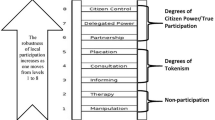Abstract
There is increasing interest in farmers’ organizations as an effective approach to farmer participatory research (FPR). Using data from an empirical study of farmers’ research groups (FRGs) in Uganda, this paper examines the patterns of participation in groups and answers questions such as: Who participates? What types of participation? How does participation occur? What are the factors determining participation? Results show that there is no single type of participation, but rather that FPR is a dynamic process with types of participation varying at different stages of the process. Farmers’ participation does not follow the normal adoption curve. Rather, it is characterized by high participation at the initial stages, followed by dramatic decrease and dropping-out, and slow increases toward the end. There is usually significantly higher participation among male farmers at the beginning of the process. However, as FRGs evolve, the proportion of men decreases sharply while the relative proportion of women continues to increase until it dominates the group. The findings do not support the common assumption that groups usually exclude women and the poor. On the contrary, we argue that FRGs are an effective mechanism to provide women and the poor with opportunities to participate in research. However, to be effective, this requires moving beyond head counting to promote more proactive gender and equity perspectives for amplifying the benefits of agricultural research to those who tend to be marginalized or excluded by mainstream development initiatives. This will be critical for making agricultural research more client-oriented and demand-driven.
Similar content being viewed by others
Abbreviations
- FRG:
-
farmer research groups
- FPR:
-
farmer participation research
- AHI:
-
Africa highlands initiative
- Q of P:
-
quality of participation
- NRM:
-
natural resource management
References
AHI (African Highlands Initiative) (1997). Phase II Work Plan and Budget 1998–2000. Nairobi, Kenya: International Centre for Research Agroforestry
Akerkar, S. (2001). Gender and Participation. Overview Report. BRIDGE Development – Gender. London, UK: Institute of Development Studies
Ashby J. A. (2003). Uniting science and participation in the process of innovation-research for development. In: B. Pound, S. Snapp, C. McDougall, A. Braun (eds.) Managing Natural Resources for Sustainable Livelihoods: Uniting Science and Participation. London, UK: Earthscan Publications and the International Development Research Centre, pp. 1–19
Ashby, J. A. and L. Sperling (1994). “Institutionalizing participatory, client-driven research and technology development in agriculture.” Agricultural Administration Research and Extension Network. Paper 49. London, UK: ODI
Ashby J. A., Braun A. R., Garcia T., Guerrero M. P., Hernandez L. A., Quiros C. A., Roa J. I. (2000). Investing in Farmers as Researchers: Experiences with Local Agricultural Research Committees in Latin America. Cali, Colombia: CIAT
Bebbington, A. J., D. Merill-Sands, and J. Ferrington (1994). “Farmer and community organizations in agriculture and extension: Functions, impacts and questions.” Agricultural Administration Research and Extension Network. Paper 47. London, UK: ODI
Biggs, S. (1989). “Proposed methodology for analyzing farmer participation in the ISNAR OFCOR study.” Agricultural Administration Research and Extension Network. Paper 17. London, UK: ODI
Braun, A. R., G. Thiele, and M. Fernandez (2000). “Farmer field schools and local agricultural research communities: Complementary platforms for integrated decision making in sustainable agriculture.’’ Agricultural Extension Network. Paper 105. London, UK: ODI
CIMMYT (1993) The Adoption of Agricultural Technology: A Guide for Survey Design. Mexico, D.F.: CIMMYT
Cornwall A. (2003) Whose voices? Whose choices? Reflections on gender and participatory Development. World Development 31(8): 1325–1342
Feder G., Umali D. L. (1993) The adoption of agricultural innovations: A review. Technological Forecasting and Social Change 43: 215–239
Feder G., Just R. E., Zilberman D. (1985) Adoption of agricultural innovations in developing countries: A survey. Economic Development and Cultural Change 33(2): 255–298
Gabre-Madhin E., Haggblade S. (2004) Successes in African agriculture: Results of an expert survey. World Development 32(5): 745–766
Gradin B. (1988). Wealth Ranking in Smallholder Communities: A Field Manual London, UK: Intermediate Technology Publications
Hagmann, J., E. Chuma, K. Murwira, and M. Connoly (1999). “Putting process into practice: Operationalizing participatory extension.” Agricultural Administration Research and Extension Network. Paper 94. London, UK: ODI
Heinrich, G. (1993). Strengthening Farmer Participation through Groups: Experiences and Lessons from Bostwana. OFCOR Discussion Paper 3. The Hague, Netherlands: ISNAR
Humphries, S. A., J. Gonzales, J. Jimenez, and F. Sierra (2000). “Searching for sustainable land use practices in Honduras: Lessons from a programme of participatory research with hillside farmers.” Agricultural Research and Extension Network. Paper 104. London, UK: ODI
Jassey, K. (2000). “Farmer research group: Who benefits?” In␣G. M. Heinrich (ed.), Farmer Participatory Approaches: Proceedings of the Regional Workshop on Farmer Participatory Approaches (pp. 111–136). Bulawayo, Zimbabwe: ICRISAT
Johnson N. L., Lilja N. K., Ashby J. A. (2003) Measuring the impact of user participation in agricultural and natural resource management research. Agricultural Systems 78: 287–306
LEISA (Low External Input and Sustainable Agriculture) (2003). Leaarning with farmer field schools. Magazine on Low External Input and Sustainable Agriculture 19(1): 5–31
Lia T. F. (1994). Interpreting Probability Models. Logit, Probit and Other Generalized Linear Models. Thousand Oaks, California: Sage University
Lilja, N. and J. Ashby (2000). Types of Participation Based on Locus of Decision-making. PRGA working document #6. Cali, Colombia: CIAT
Martin A., Sherrington J. (1997) Participatory research methods: Implementation, effectiveness and institutional context. Agricultural Systems 55(2): 195–216
Oakley P. (1992). Projects with People: The Practice of Participation in Rural Development. Geneva, Switzerland: International Labor Office
Okali C., Sumberg J., Farrington J. (1994) Farmer Participatory Research: Rhetoric and Reality London, UK: Intermediate Technology Publications
Opondo, C., P. Sanginga, and A. Stroud (2003). “Monitoring the outcomes of participatory research in natural resource␣management: Experiences of the African Highlands Initiative.” In C. Wettasinha, L. van Veldhuizen, and A.␣Waters-Bayer (eds.), Advancing Participatory Technology Development: Case Studies on Integration into Agricultural Research, Extension and Education (pp. 39–60). Silang, Cavite, Philippines: IRR/ETC Ecoculture/CTA
Pretty J. (2003). Social capital and the collective management of resources. Science 32: 1912–1914
Pretty J., Guijt I., Thompson J., Scoones I. (1995). Participatory Learning and Action: A Trainer’s Guide London, UK: International Institute for Environment and Development
Pound B., Snapp S., McDougall C., Braun A. (2003). Managing Natural Resources for Sustainable Livelihoods. Uniting Science and Participation. London, UK: Earthscan Publications
PRGA (Participatory Research and Gender Analysis) (1997). New Frontiers in Participatory Research and Gender Analysis. Proceedings of the International Seminar on Participatory Research and Gender Analysis for Technology Development and Institutional Innovation. Cali, Colombia: CIAT
Rogers E. M. (1995). Diffusion of Innovations (4th ed). New York: The Free Press
Selener D. (1997). Participatory Action Research and Social Change. Cornell Participatory Action Research Network. Ithaca, New York: Cornell University
Stroud A. (2003). Transforming institutions to achieve innovation in research and development In: B. Pound, S. Snapp, C. McDougall, A. Braun (eds.) Managing Natural Resources for Sustainable Livelihoods. Uniting Science and Participation. London, UK: Earthscan Publications, pp. 88–112
Uphoff N. (1988). Participatory evaluation of farmers’ organizations’ capacity for development tasks. Agricultural Administration and Extension 30: 43–64
Uphoff N., Mijayaratna C. M. (2000). Demonstrated benefits of social capital: The productivity of farmers’ organizations in Gal Oya, Sri Lanka. World Development 28(11): 1875–1840
Vernooy R., McDougall C. (2003) Principles of good practice in participatory research: Reflecting on lessons from the field In: Pound B., Snapp S., McDougall C., Braun A. (eds.) Managing Natural Resources for Sustainable Livelihoods: Uniting Science and Participation. London, UK: Earthscan Publications, pp. 113–141
World Bank (1998) The World Bank Participation Source Book. Washington DC: ESD, The World Bank
Acknowledgments
We are grateful to the hundreds of female and male farmers in Kabale who provided the substance of this␣paper. We thank Roger Kirkby, Ann Stroud, and Jacqueline Ashby for their support and encouragement in various ways. The CGIAR, System-wide Programme on Participatory Research and Gender Analysis (PRGA) funded this study through a small grant provided by the German Department of Technical Cooperation (BMZ).
Author information
Authors and Affiliations
Corresponding author
Additional information
Pascal C. Sanginga is a Rural Sociologist with the Rural Innovation Institute of the International Centre for Tropical Agriculture based in Uganda. He is currently working on the multi-stakeholder, research-for-development project, “Enabling Rural Innovation” (ERI) in Africa in partnerships with national agricultural research and extension systems, non-governmental organizations, and farmers’ organizations in eastern and southern Africa.
Nina Lilja is an Agricultural Economist working on an impact assessment of participatory research with the System-wide Programme on Participatory Research and Gender Analysis for Technology Development and Institutional Innovation.
Jackson Tumwine was a Research Assistant with the Africa Highlands Initiative based in Kabale, Uganda at the time of this study. He is now pursuing his PhD and conducting field research at the International Centre for Tropical Agriculture (CIAT) in Uganda.
Rights and permissions
About this article
Cite this article
Sanginga, P.C., Tumwine, J. & Lilja, N.K. Patterns of participation in farmers’ research groups: Lessons from the highlands of southwestern Uganda. Agric Hum Values 23, 501–512 (2006). https://doi.org/10.1007/s10460-006-9018-0
Accepted:
Published:
Issue Date:
DOI: https://doi.org/10.1007/s10460-006-9018-0




